Comparative Analysis of BP and Shell: Strategic Business Strategies
VerifiedAdded on 2022/12/26
|10
|3306
|40
Report
AI Summary
This report provides a comprehensive analysis of the strategic business and change management practices of BP and Shell, two major players in the oil and gas industry. It delves into the dynamic global environment, emphasizing the necessity for strategic planning and change management. The report utilizes the Wheelen Strategic Management Model to examine environmental scanning, strategy formulation, and evaluation. It compares PESTEL analyses, SWOT analyses, and Porter's 5 Forces, highlighting their impact on strategic decision-making. Furthermore, the report explores conceptual and practical approaches to strategic business, including McKinsey's 7S model and the reasons for change within these organizations. It also discusses prescriptive and emergent strategies, along with the definition, benefits, and drawbacks of KPIs, benchmarking, and how these are applied within BP and Shell. The report offers a detailed comparison of the companies' strategic approaches, providing valuable insights into their adaptation to the changing business landscape.
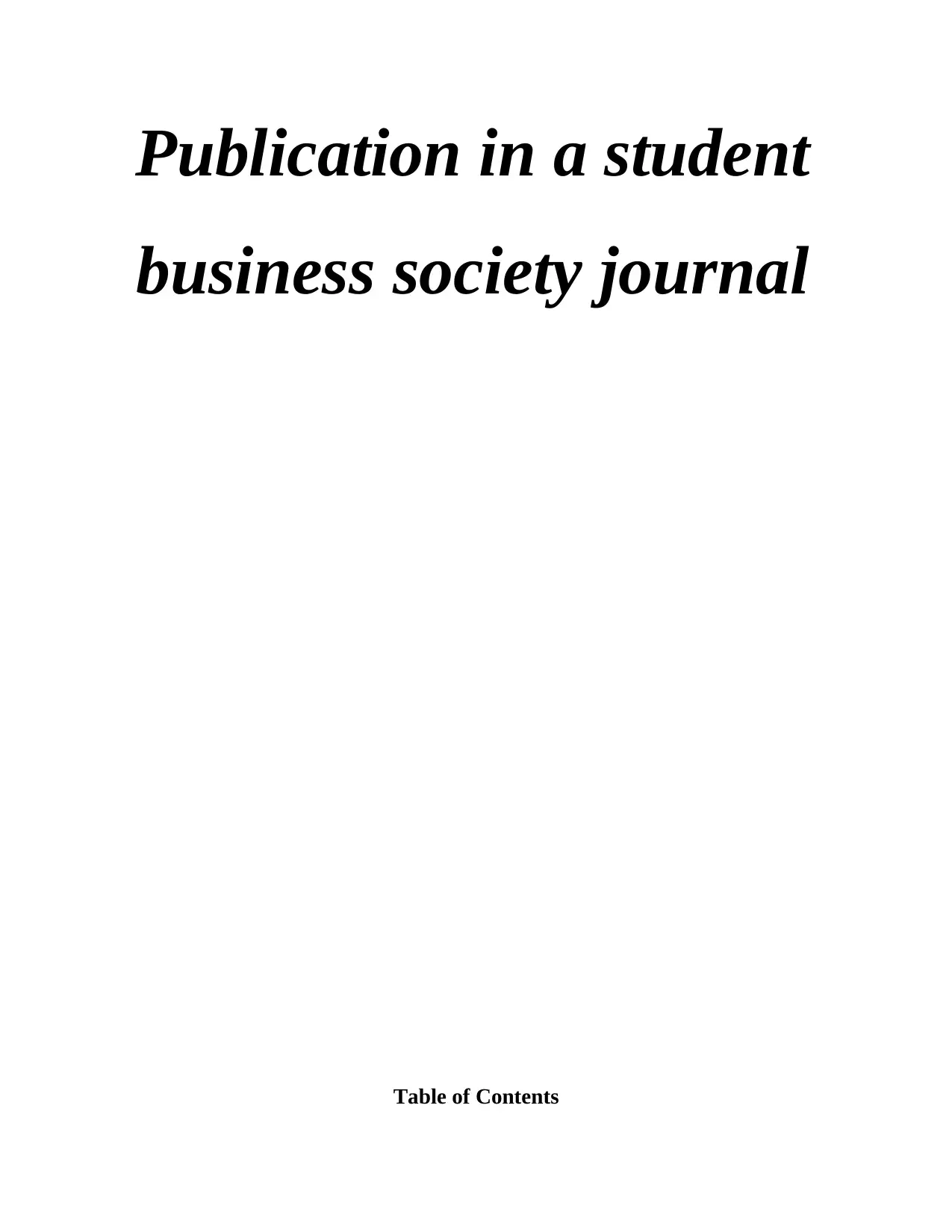
Publication in a student
business society journal
Table of Contents
business society journal
Table of Contents
Paraphrase This Document
Need a fresh take? Get an instant paraphrase of this document with our AI Paraphraser
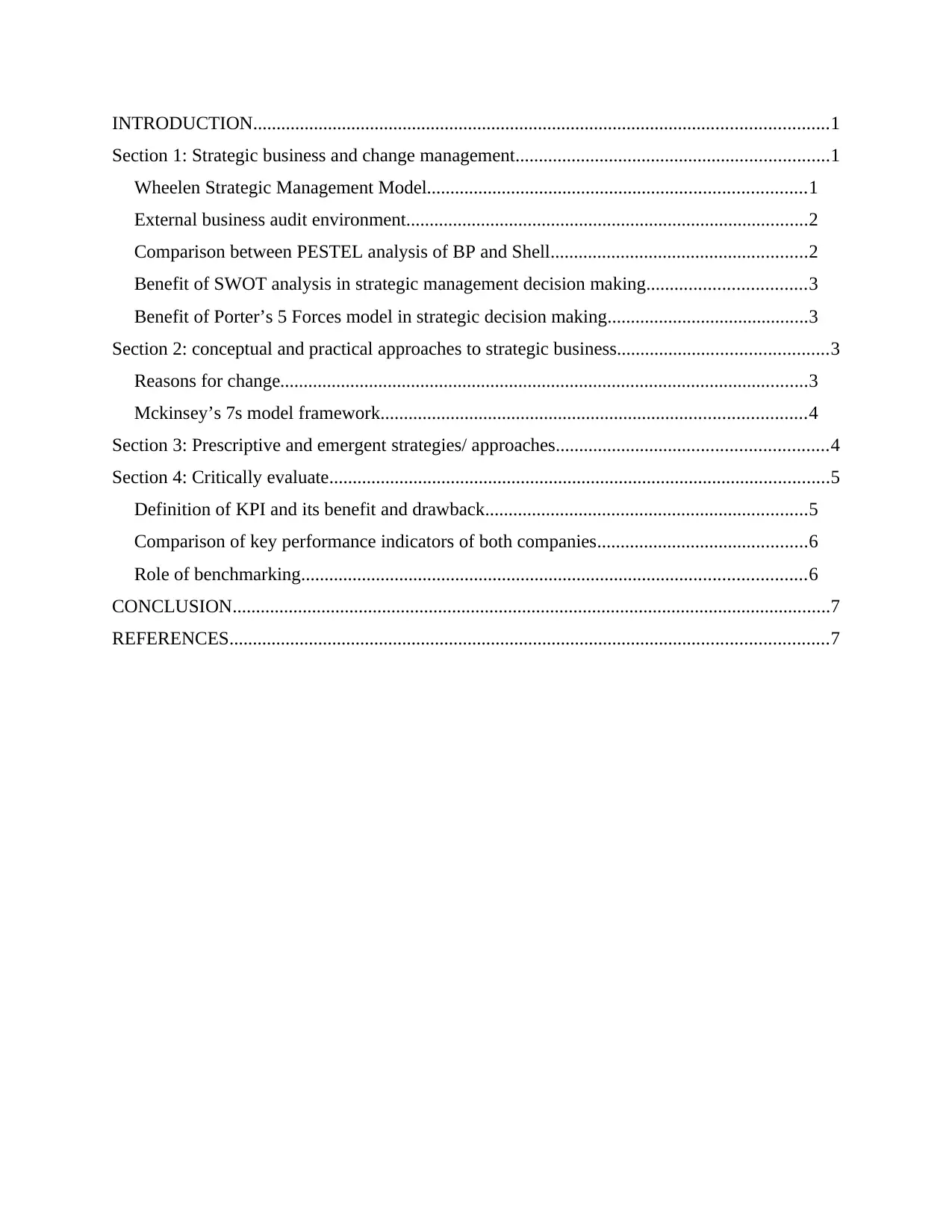
INTRODUCTION...........................................................................................................................1
Section 1: Strategic business and change management...................................................................1
Wheelen Strategic Management Model.................................................................................1
External business audit environment......................................................................................2
Comparison between PESTEL analysis of BP and Shell.......................................................2
Benefit of SWOT analysis in strategic management decision making..................................3
Benefit of Porter’s 5 Forces model in strategic decision making...........................................3
Section 2: conceptual and practical approaches to strategic business.............................................3
Reasons for change.................................................................................................................3
Mckinsey’s 7s model framework...........................................................................................4
Section 3: Prescriptive and emergent strategies/ approaches..........................................................4
Section 4: Critically evaluate...........................................................................................................5
Definition of KPI and its benefit and drawback.....................................................................5
Comparison of key performance indicators of both companies.............................................6
Role of benchmarking............................................................................................................6
CONCLUSION................................................................................................................................7
REFERENCES................................................................................................................................7
Section 1: Strategic business and change management...................................................................1
Wheelen Strategic Management Model.................................................................................1
External business audit environment......................................................................................2
Comparison between PESTEL analysis of BP and Shell.......................................................2
Benefit of SWOT analysis in strategic management decision making..................................3
Benefit of Porter’s 5 Forces model in strategic decision making...........................................3
Section 2: conceptual and practical approaches to strategic business.............................................3
Reasons for change.................................................................................................................3
Mckinsey’s 7s model framework...........................................................................................4
Section 3: Prescriptive and emergent strategies/ approaches..........................................................4
Section 4: Critically evaluate...........................................................................................................5
Definition of KPI and its benefit and drawback.....................................................................5
Comparison of key performance indicators of both companies.............................................6
Role of benchmarking............................................................................................................6
CONCLUSION................................................................................................................................7
REFERENCES................................................................................................................................7
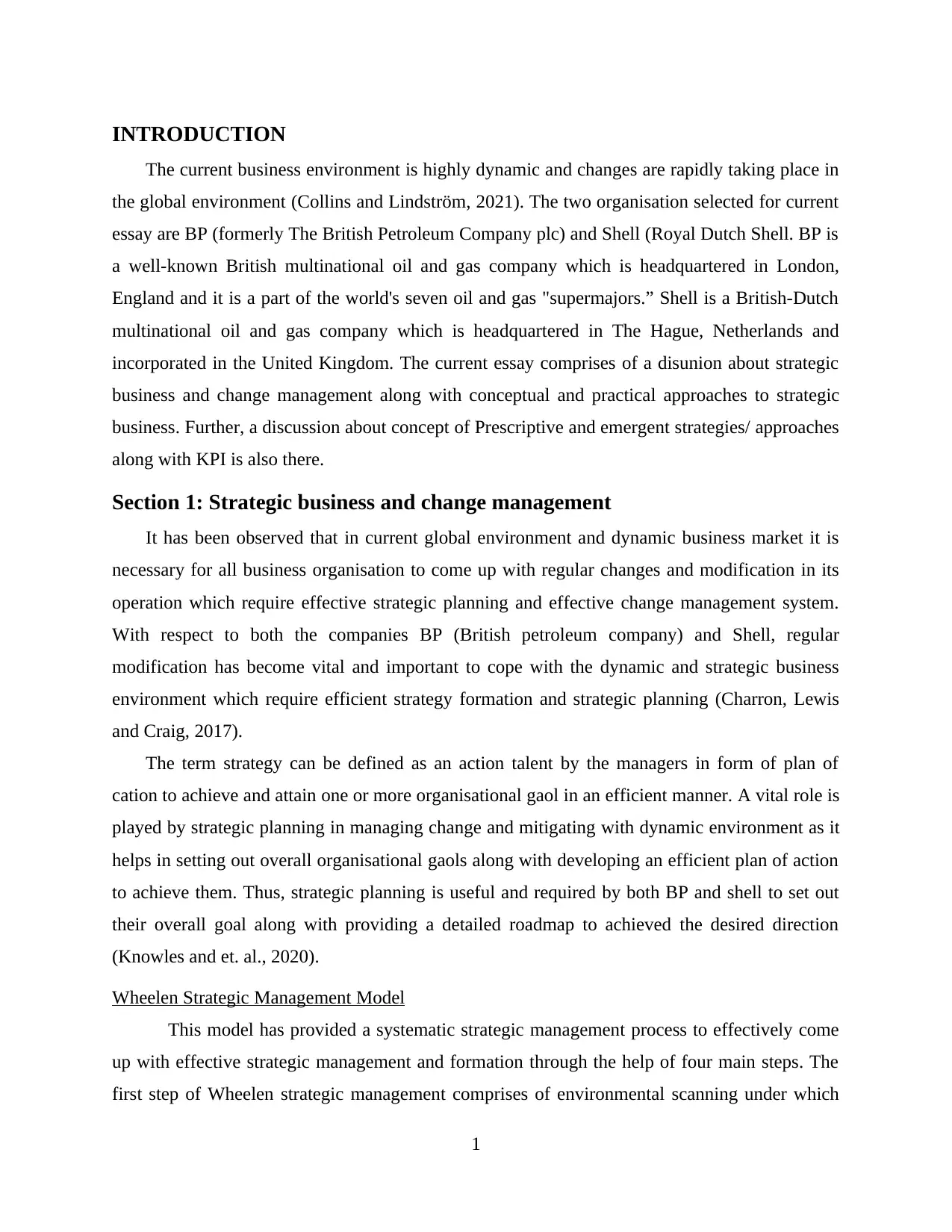
INTRODUCTION
The current business environment is highly dynamic and changes are rapidly taking place in
the global environment (Collins and Lindström, 2021). The two organisation selected for current
essay are BP (formerly The British Petroleum Company plc) and Shell (Royal Dutch Shell. BP is
a well-known British multinational oil and gas company which is headquartered in London,
England and it is a part of the world's seven oil and gas "supermajors.” Shell is a British-Dutch
multinational oil and gas company which is headquartered in The Hague, Netherlands and
incorporated in the United Kingdom. The current essay comprises of a disunion about strategic
business and change management along with conceptual and practical approaches to strategic
business. Further, a discussion about concept of Prescriptive and emergent strategies/ approaches
along with KPI is also there.
Section 1: Strategic business and change management
It has been observed that in current global environment and dynamic business market it is
necessary for all business organisation to come up with regular changes and modification in its
operation which require effective strategic planning and effective change management system.
With respect to both the companies BP (British petroleum company) and Shell, regular
modification has become vital and important to cope with the dynamic and strategic business
environment which require efficient strategy formation and strategic planning (Charron, Lewis
and Craig, 2017).
The term strategy can be defined as an action talent by the managers in form of plan of
cation to achieve and attain one or more organisational gaol in an efficient manner. A vital role is
played by strategic planning in managing change and mitigating with dynamic environment as it
helps in setting out overall organisational gaols along with developing an efficient plan of action
to achieve them. Thus, strategic planning is useful and required by both BP and shell to set out
their overall goal along with providing a detailed roadmap to achieved the desired direction
(Knowles and et. al., 2020).
Wheelen Strategic Management Model
This model has provided a systematic strategic management process to effectively come
up with effective strategic management and formation through the help of four main steps. The
first step of Wheelen strategic management comprises of environmental scanning under which
1
The current business environment is highly dynamic and changes are rapidly taking place in
the global environment (Collins and Lindström, 2021). The two organisation selected for current
essay are BP (formerly The British Petroleum Company plc) and Shell (Royal Dutch Shell. BP is
a well-known British multinational oil and gas company which is headquartered in London,
England and it is a part of the world's seven oil and gas "supermajors.” Shell is a British-Dutch
multinational oil and gas company which is headquartered in The Hague, Netherlands and
incorporated in the United Kingdom. The current essay comprises of a disunion about strategic
business and change management along with conceptual and practical approaches to strategic
business. Further, a discussion about concept of Prescriptive and emergent strategies/ approaches
along with KPI is also there.
Section 1: Strategic business and change management
It has been observed that in current global environment and dynamic business market it is
necessary for all business organisation to come up with regular changes and modification in its
operation which require effective strategic planning and effective change management system.
With respect to both the companies BP (British petroleum company) and Shell, regular
modification has become vital and important to cope with the dynamic and strategic business
environment which require efficient strategy formation and strategic planning (Charron, Lewis
and Craig, 2017).
The term strategy can be defined as an action talent by the managers in form of plan of
cation to achieve and attain one or more organisational gaol in an efficient manner. A vital role is
played by strategic planning in managing change and mitigating with dynamic environment as it
helps in setting out overall organisational gaols along with developing an efficient plan of action
to achieve them. Thus, strategic planning is useful and required by both BP and shell to set out
their overall goal along with providing a detailed roadmap to achieved the desired direction
(Knowles and et. al., 2020).
Wheelen Strategic Management Model
This model has provided a systematic strategic management process to effectively come
up with effective strategic management and formation through the help of four main steps. The
first step of Wheelen strategic management comprises of environmental scanning under which
1
⊘ This is a preview!⊘
Do you want full access?
Subscribe today to unlock all pages.

Trusted by 1+ million students worldwide
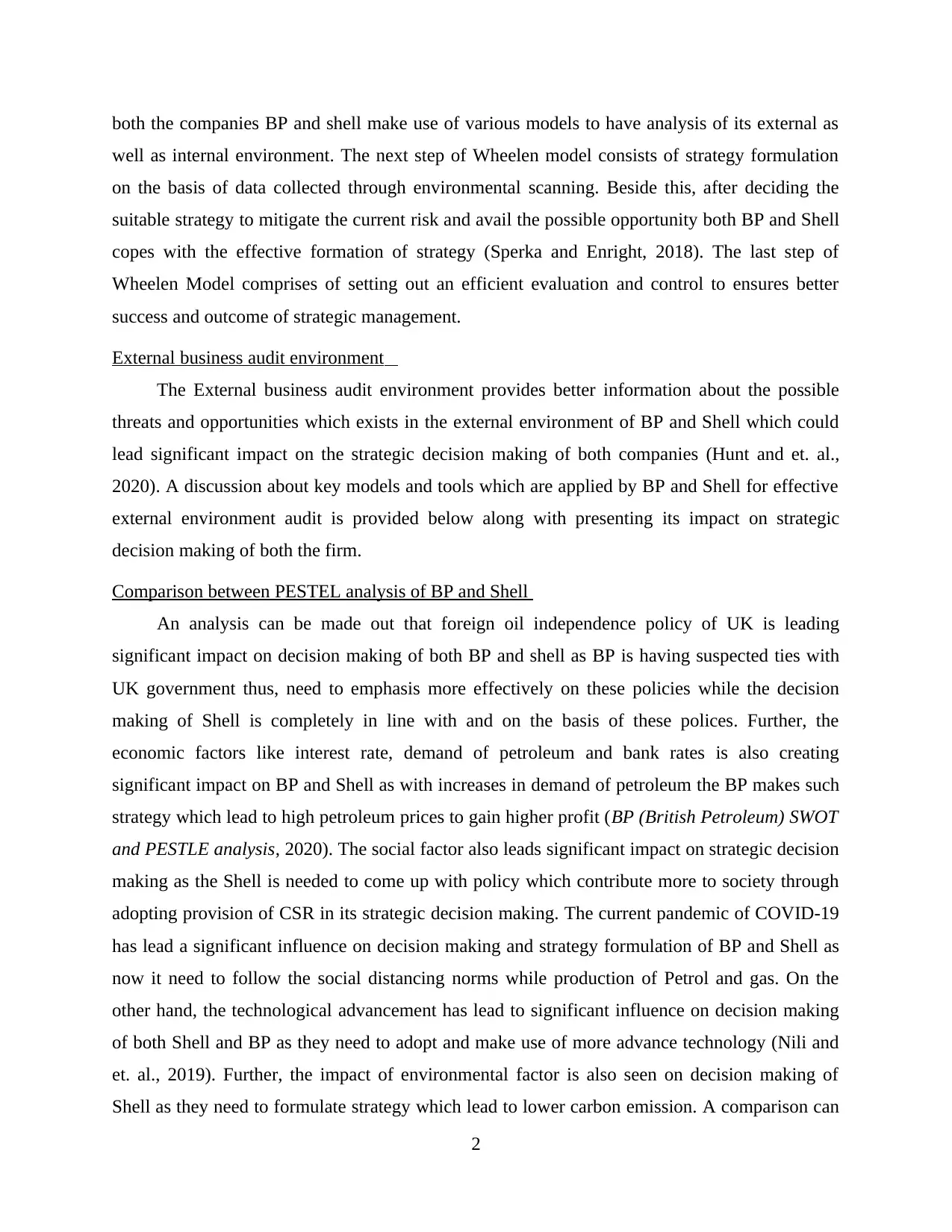
both the companies BP and shell make use of various models to have analysis of its external as
well as internal environment. The next step of Wheelen model consists of strategy formulation
on the basis of data collected through environmental scanning. Beside this, after deciding the
suitable strategy to mitigate the current risk and avail the possible opportunity both BP and Shell
copes with the effective formation of strategy (Sperka and Enright, 2018). The last step of
Wheelen Model comprises of setting out an efficient evaluation and control to ensures better
success and outcome of strategic management.
External business audit environment
The External business audit environment provides better information about the possible
threats and opportunities which exists in the external environment of BP and Shell which could
lead significant impact on the strategic decision making of both companies (Hunt and et. al.,
2020). A discussion about key models and tools which are applied by BP and Shell for effective
external environment audit is provided below along with presenting its impact on strategic
decision making of both the firm.
Comparison between PESTEL analysis of BP and Shell
An analysis can be made out that foreign oil independence policy of UK is leading
significant impact on decision making of both BP and shell as BP is having suspected ties with
UK government thus, need to emphasis more effectively on these policies while the decision
making of Shell is completely in line with and on the basis of these polices. Further, the
economic factors like interest rate, demand of petroleum and bank rates is also creating
significant impact on BP and Shell as with increases in demand of petroleum the BP makes such
strategy which lead to high petroleum prices to gain higher profit (BP (British Petroleum) SWOT
and PESTLE analysis, 2020). The social factor also leads significant impact on strategic decision
making as the Shell is needed to come up with policy which contribute more to society through
adopting provision of CSR in its strategic decision making. The current pandemic of COVID-19
has lead a significant influence on decision making and strategy formulation of BP and Shell as
now it need to follow the social distancing norms while production of Petrol and gas. On the
other hand, the technological advancement has lead to significant influence on decision making
of both Shell and BP as they need to adopt and make use of more advance technology (Nili and
et. al., 2019). Further, the impact of environmental factor is also seen on decision making of
Shell as they need to formulate strategy which lead to lower carbon emission. A comparison can
2
well as internal environment. The next step of Wheelen model consists of strategy formulation
on the basis of data collected through environmental scanning. Beside this, after deciding the
suitable strategy to mitigate the current risk and avail the possible opportunity both BP and Shell
copes with the effective formation of strategy (Sperka and Enright, 2018). The last step of
Wheelen Model comprises of setting out an efficient evaluation and control to ensures better
success and outcome of strategic management.
External business audit environment
The External business audit environment provides better information about the possible
threats and opportunities which exists in the external environment of BP and Shell which could
lead significant impact on the strategic decision making of both companies (Hunt and et. al.,
2020). A discussion about key models and tools which are applied by BP and Shell for effective
external environment audit is provided below along with presenting its impact on strategic
decision making of both the firm.
Comparison between PESTEL analysis of BP and Shell
An analysis can be made out that foreign oil independence policy of UK is leading
significant impact on decision making of both BP and shell as BP is having suspected ties with
UK government thus, need to emphasis more effectively on these policies while the decision
making of Shell is completely in line with and on the basis of these polices. Further, the
economic factors like interest rate, demand of petroleum and bank rates is also creating
significant impact on BP and Shell as with increases in demand of petroleum the BP makes such
strategy which lead to high petroleum prices to gain higher profit (BP (British Petroleum) SWOT
and PESTLE analysis, 2020). The social factor also leads significant impact on strategic decision
making as the Shell is needed to come up with policy which contribute more to society through
adopting provision of CSR in its strategic decision making. The current pandemic of COVID-19
has lead a significant influence on decision making and strategy formulation of BP and Shell as
now it need to follow the social distancing norms while production of Petrol and gas. On the
other hand, the technological advancement has lead to significant influence on decision making
of both Shell and BP as they need to adopt and make use of more advance technology (Nili and
et. al., 2019). Further, the impact of environmental factor is also seen on decision making of
Shell as they need to formulate strategy which lead to lower carbon emission. A comparison can
2
Paraphrase This Document
Need a fresh take? Get an instant paraphrase of this document with our AI Paraphraser
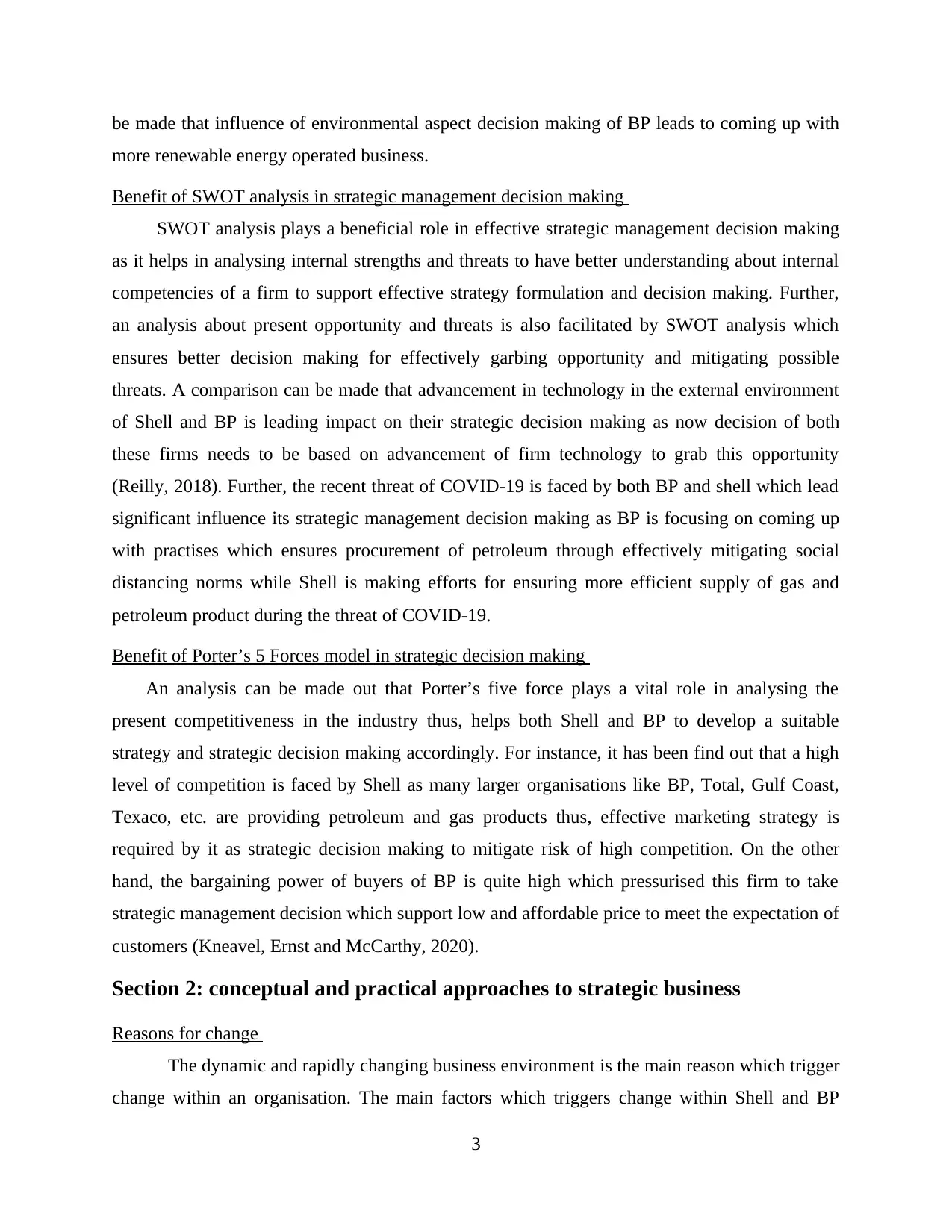
be made that influence of environmental aspect decision making of BP leads to coming up with
more renewable energy operated business.
Benefit of SWOT analysis in strategic management decision making
SWOT analysis plays a beneficial role in effective strategic management decision making
as it helps in analysing internal strengths and threats to have better understanding about internal
competencies of a firm to support effective strategy formulation and decision making. Further,
an analysis about present opportunity and threats is also facilitated by SWOT analysis which
ensures better decision making for effectively garbing opportunity and mitigating possible
threats. A comparison can be made that advancement in technology in the external environment
of Shell and BP is leading impact on their strategic decision making as now decision of both
these firms needs to be based on advancement of firm technology to grab this opportunity
(Reilly, 2018). Further, the recent threat of COVID-19 is faced by both BP and shell which lead
significant influence its strategic management decision making as BP is focusing on coming up
with practises which ensures procurement of petroleum through effectively mitigating social
distancing norms while Shell is making efforts for ensuring more efficient supply of gas and
petroleum product during the threat of COVID-19.
Benefit of Porter’s 5 Forces model in strategic decision making
An analysis can be made out that Porter’s five force plays a vital role in analysing the
present competitiveness in the industry thus, helps both Shell and BP to develop a suitable
strategy and strategic decision making accordingly. For instance, it has been find out that a high
level of competition is faced by Shell as many larger organisations like BP, Total, Gulf Coast,
Texaco, etc. are providing petroleum and gas products thus, effective marketing strategy is
required by it as strategic decision making to mitigate risk of high competition. On the other
hand, the bargaining power of buyers of BP is quite high which pressurised this firm to take
strategic management decision which support low and affordable price to meet the expectation of
customers (Kneavel, Ernst and McCarthy, 2020).
Section 2: conceptual and practical approaches to strategic business
Reasons for change
The dynamic and rapidly changing business environment is the main reason which trigger
change within an organisation. The main factors which triggers change within Shell and BP
3
more renewable energy operated business.
Benefit of SWOT analysis in strategic management decision making
SWOT analysis plays a beneficial role in effective strategic management decision making
as it helps in analysing internal strengths and threats to have better understanding about internal
competencies of a firm to support effective strategy formulation and decision making. Further,
an analysis about present opportunity and threats is also facilitated by SWOT analysis which
ensures better decision making for effectively garbing opportunity and mitigating possible
threats. A comparison can be made that advancement in technology in the external environment
of Shell and BP is leading impact on their strategic decision making as now decision of both
these firms needs to be based on advancement of firm technology to grab this opportunity
(Reilly, 2018). Further, the recent threat of COVID-19 is faced by both BP and shell which lead
significant influence its strategic management decision making as BP is focusing on coming up
with practises which ensures procurement of petroleum through effectively mitigating social
distancing norms while Shell is making efforts for ensuring more efficient supply of gas and
petroleum product during the threat of COVID-19.
Benefit of Porter’s 5 Forces model in strategic decision making
An analysis can be made out that Porter’s five force plays a vital role in analysing the
present competitiveness in the industry thus, helps both Shell and BP to develop a suitable
strategy and strategic decision making accordingly. For instance, it has been find out that a high
level of competition is faced by Shell as many larger organisations like BP, Total, Gulf Coast,
Texaco, etc. are providing petroleum and gas products thus, effective marketing strategy is
required by it as strategic decision making to mitigate risk of high competition. On the other
hand, the bargaining power of buyers of BP is quite high which pressurised this firm to take
strategic management decision which support low and affordable price to meet the expectation of
customers (Kneavel, Ernst and McCarthy, 2020).
Section 2: conceptual and practical approaches to strategic business
Reasons for change
The dynamic and rapidly changing business environment is the main reason which trigger
change within an organisation. The main factors which triggers change within Shell and BP
3
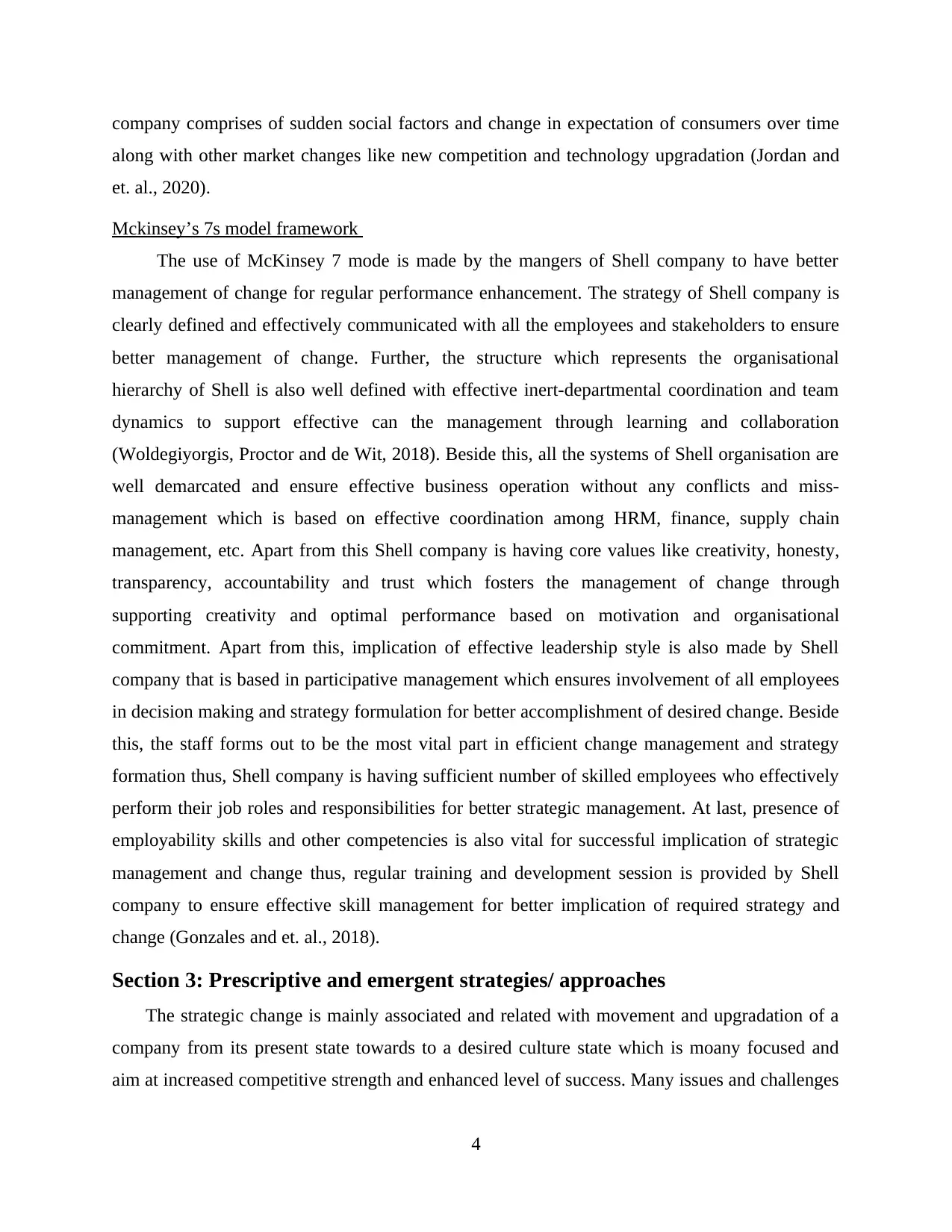
company comprises of sudden social factors and change in expectation of consumers over time
along with other market changes like new competition and technology upgradation (Jordan and
et. al., 2020).
Mckinsey’s 7s model framework
The use of McKinsey 7 mode is made by the mangers of Shell company to have better
management of change for regular performance enhancement. The strategy of Shell company is
clearly defined and effectively communicated with all the employees and stakeholders to ensure
better management of change. Further, the structure which represents the organisational
hierarchy of Shell is also well defined with effective inert-departmental coordination and team
dynamics to support effective can the management through learning and collaboration
(Woldegiyorgis, Proctor and de Wit, 2018). Beside this, all the systems of Shell organisation are
well demarcated and ensure effective business operation without any conflicts and miss-
management which is based on effective coordination among HRM, finance, supply chain
management, etc. Apart from this Shell company is having core values like creativity, honesty,
transparency, accountability and trust which fosters the management of change through
supporting creativity and optimal performance based on motivation and organisational
commitment. Apart from this, implication of effective leadership style is also made by Shell
company that is based in participative management which ensures involvement of all employees
in decision making and strategy formulation for better accomplishment of desired change. Beside
this, the staff forms out to be the most vital part in efficient change management and strategy
formation thus, Shell company is having sufficient number of skilled employees who effectively
perform their job roles and responsibilities for better strategic management. At last, presence of
employability skills and other competencies is also vital for successful implication of strategic
management and change thus, regular training and development session is provided by Shell
company to ensure effective skill management for better implication of required strategy and
change (Gonzales and et. al., 2018).
Section 3: Prescriptive and emergent strategies/ approaches
The strategic change is mainly associated and related with movement and upgradation of a
company from its present state towards to a desired culture state which is moany focused and
aim at increased competitive strength and enhanced level of success. Many issues and challenges
4
along with other market changes like new competition and technology upgradation (Jordan and
et. al., 2020).
Mckinsey’s 7s model framework
The use of McKinsey 7 mode is made by the mangers of Shell company to have better
management of change for regular performance enhancement. The strategy of Shell company is
clearly defined and effectively communicated with all the employees and stakeholders to ensure
better management of change. Further, the structure which represents the organisational
hierarchy of Shell is also well defined with effective inert-departmental coordination and team
dynamics to support effective can the management through learning and collaboration
(Woldegiyorgis, Proctor and de Wit, 2018). Beside this, all the systems of Shell organisation are
well demarcated and ensure effective business operation without any conflicts and miss-
management which is based on effective coordination among HRM, finance, supply chain
management, etc. Apart from this Shell company is having core values like creativity, honesty,
transparency, accountability and trust which fosters the management of change through
supporting creativity and optimal performance based on motivation and organisational
commitment. Apart from this, implication of effective leadership style is also made by Shell
company that is based in participative management which ensures involvement of all employees
in decision making and strategy formulation for better accomplishment of desired change. Beside
this, the staff forms out to be the most vital part in efficient change management and strategy
formation thus, Shell company is having sufficient number of skilled employees who effectively
perform their job roles and responsibilities for better strategic management. At last, presence of
employability skills and other competencies is also vital for successful implication of strategic
management and change thus, regular training and development session is provided by Shell
company to ensure effective skill management for better implication of required strategy and
change (Gonzales and et. al., 2018).
Section 3: Prescriptive and emergent strategies/ approaches
The strategic change is mainly associated and related with movement and upgradation of a
company from its present state towards to a desired culture state which is moany focused and
aim at increased competitive strength and enhanced level of success. Many issues and challenges
4
⊘ This is a preview!⊘
Do you want full access?
Subscribe today to unlock all pages.

Trusted by 1+ million students worldwide
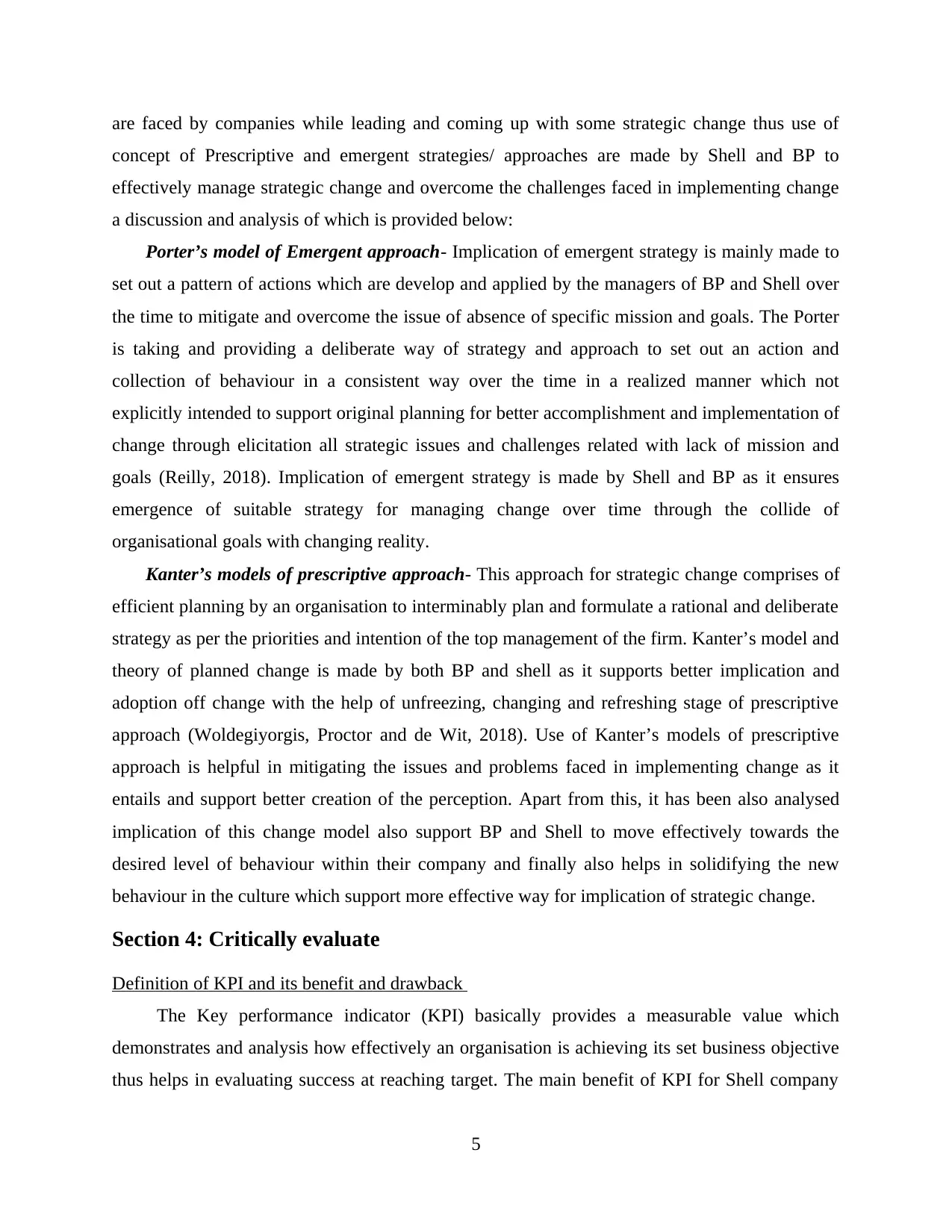
are faced by companies while leading and coming up with some strategic change thus use of
concept of Prescriptive and emergent strategies/ approaches are made by Shell and BP to
effectively manage strategic change and overcome the challenges faced in implementing change
a discussion and analysis of which is provided below:
Porter’s model of Emergent approach- Implication of emergent strategy is mainly made to
set out a pattern of actions which are develop and applied by the managers of BP and Shell over
the time to mitigate and overcome the issue of absence of specific mission and goals. The Porter
is taking and providing a deliberate way of strategy and approach to set out an action and
collection of behaviour in a consistent way over the time in a realized manner which not
explicitly intended to support original planning for better accomplishment and implementation of
change through elicitation all strategic issues and challenges related with lack of mission and
goals (Reilly, 2018). Implication of emergent strategy is made by Shell and BP as it ensures
emergence of suitable strategy for managing change over time through the collide of
organisational goals with changing reality.
Kanter’s models of prescriptive approach- This approach for strategic change comprises of
efficient planning by an organisation to interminably plan and formulate a rational and deliberate
strategy as per the priorities and intention of the top management of the firm. Kanter’s model and
theory of planned change is made by both BP and shell as it supports better implication and
adoption off change with the help of unfreezing, changing and refreshing stage of prescriptive
approach (Woldegiyorgis, Proctor and de Wit, 2018). Use of Kanter’s models of prescriptive
approach is helpful in mitigating the issues and problems faced in implementing change as it
entails and support better creation of the perception. Apart from this, it has been also analysed
implication of this change model also support BP and Shell to move effectively towards the
desired level of behaviour within their company and finally also helps in solidifying the new
behaviour in the culture which support more effective way for implication of strategic change.
Section 4: Critically evaluate
Definition of KPI and its benefit and drawback
The Key performance indicator (KPI) basically provides a measurable value which
demonstrates and analysis how effectively an organisation is achieving its set business objective
thus helps in evaluating success at reaching target. The main benefit of KPI for Shell company
5
concept of Prescriptive and emergent strategies/ approaches are made by Shell and BP to
effectively manage strategic change and overcome the challenges faced in implementing change
a discussion and analysis of which is provided below:
Porter’s model of Emergent approach- Implication of emergent strategy is mainly made to
set out a pattern of actions which are develop and applied by the managers of BP and Shell over
the time to mitigate and overcome the issue of absence of specific mission and goals. The Porter
is taking and providing a deliberate way of strategy and approach to set out an action and
collection of behaviour in a consistent way over the time in a realized manner which not
explicitly intended to support original planning for better accomplishment and implementation of
change through elicitation all strategic issues and challenges related with lack of mission and
goals (Reilly, 2018). Implication of emergent strategy is made by Shell and BP as it ensures
emergence of suitable strategy for managing change over time through the collide of
organisational goals with changing reality.
Kanter’s models of prescriptive approach- This approach for strategic change comprises of
efficient planning by an organisation to interminably plan and formulate a rational and deliberate
strategy as per the priorities and intention of the top management of the firm. Kanter’s model and
theory of planned change is made by both BP and shell as it supports better implication and
adoption off change with the help of unfreezing, changing and refreshing stage of prescriptive
approach (Woldegiyorgis, Proctor and de Wit, 2018). Use of Kanter’s models of prescriptive
approach is helpful in mitigating the issues and problems faced in implementing change as it
entails and support better creation of the perception. Apart from this, it has been also analysed
implication of this change model also support BP and Shell to move effectively towards the
desired level of behaviour within their company and finally also helps in solidifying the new
behaviour in the culture which support more effective way for implication of strategic change.
Section 4: Critically evaluate
Definition of KPI and its benefit and drawback
The Key performance indicator (KPI) basically provides a measurable value which
demonstrates and analysis how effectively an organisation is achieving its set business objective
thus helps in evaluating success at reaching target. The main benefit of KPI for Shell company
5
Paraphrase This Document
Need a fresh take? Get an instant paraphrase of this document with our AI Paraphraser
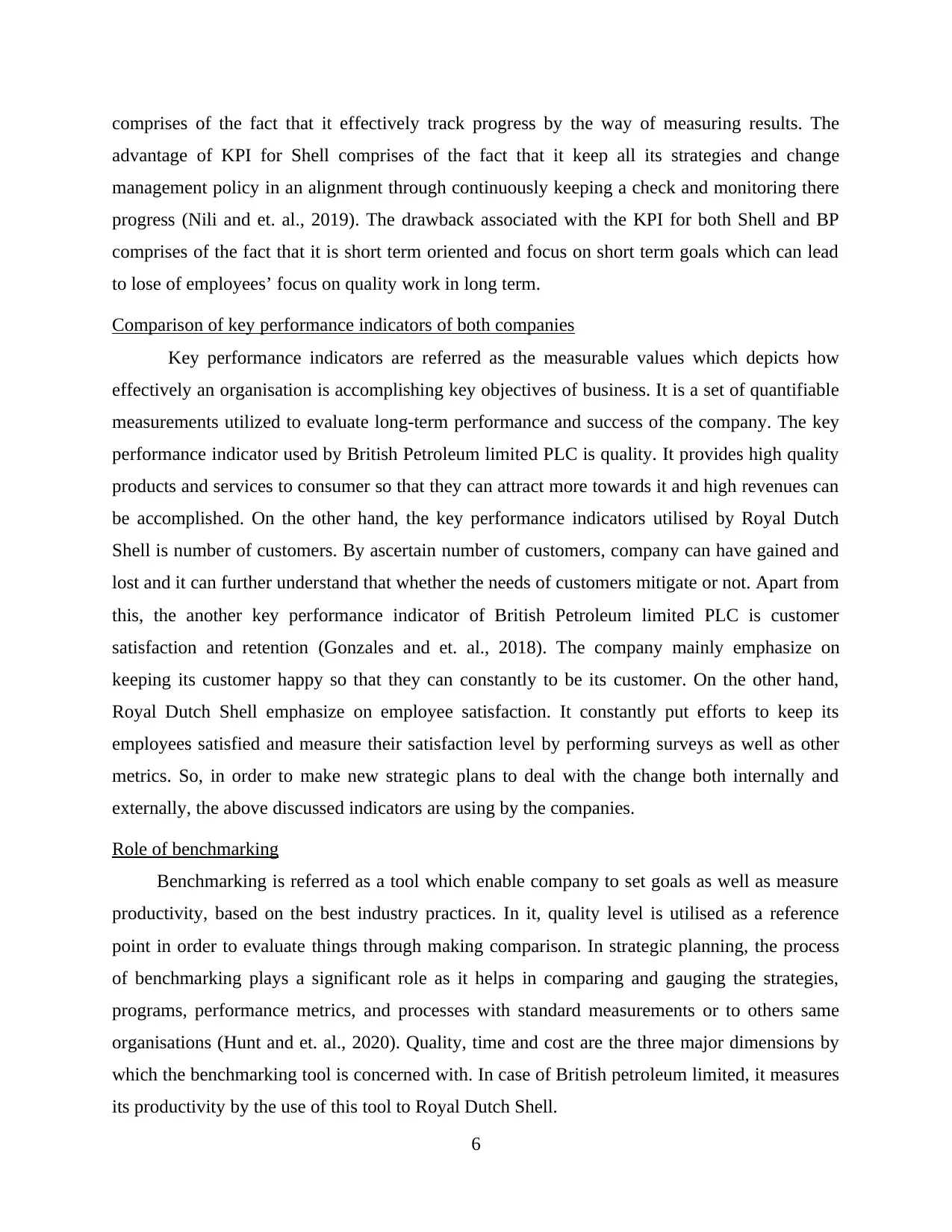
comprises of the fact that it effectively track progress by the way of measuring results. The
advantage of KPI for Shell comprises of the fact that it keep all its strategies and change
management policy in an alignment through continuously keeping a check and monitoring there
progress (Nili and et. al., 2019). The drawback associated with the KPI for both Shell and BP
comprises of the fact that it is short term oriented and focus on short term goals which can lead
to lose of employees’ focus on quality work in long term.
Comparison of key performance indicators of both companies
Key performance indicators are referred as the measurable values which depicts how
effectively an organisation is accomplishing key objectives of business. It is a set of quantifiable
measurements utilized to evaluate long-term performance and success of the company. The key
performance indicator used by British Petroleum limited PLC is quality. It provides high quality
products and services to consumer so that they can attract more towards it and high revenues can
be accomplished. On the other hand, the key performance indicators utilised by Royal Dutch
Shell is number of customers. By ascertain number of customers, company can have gained and
lost and it can further understand that whether the needs of customers mitigate or not. Apart from
this, the another key performance indicator of British Petroleum limited PLC is customer
satisfaction and retention (Gonzales and et. al., 2018). The company mainly emphasize on
keeping its customer happy so that they can constantly to be its customer. On the other hand,
Royal Dutch Shell emphasize on employee satisfaction. It constantly put efforts to keep its
employees satisfied and measure their satisfaction level by performing surveys as well as other
metrics. So, in order to make new strategic plans to deal with the change both internally and
externally, the above discussed indicators are using by the companies.
Role of benchmarking
Benchmarking is referred as a tool which enable company to set goals as well as measure
productivity, based on the best industry practices. In it, quality level is utilised as a reference
point in order to evaluate things through making comparison. In strategic planning, the process
of benchmarking plays a significant role as it helps in comparing and gauging the strategies,
programs, performance metrics, and processes with standard measurements or to others same
organisations (Hunt and et. al., 2020). Quality, time and cost are the three major dimensions by
which the benchmarking tool is concerned with. In case of British petroleum limited, it measures
its productivity by the use of this tool to Royal Dutch Shell.
6
advantage of KPI for Shell comprises of the fact that it keep all its strategies and change
management policy in an alignment through continuously keeping a check and monitoring there
progress (Nili and et. al., 2019). The drawback associated with the KPI for both Shell and BP
comprises of the fact that it is short term oriented and focus on short term goals which can lead
to lose of employees’ focus on quality work in long term.
Comparison of key performance indicators of both companies
Key performance indicators are referred as the measurable values which depicts how
effectively an organisation is accomplishing key objectives of business. It is a set of quantifiable
measurements utilized to evaluate long-term performance and success of the company. The key
performance indicator used by British Petroleum limited PLC is quality. It provides high quality
products and services to consumer so that they can attract more towards it and high revenues can
be accomplished. On the other hand, the key performance indicators utilised by Royal Dutch
Shell is number of customers. By ascertain number of customers, company can have gained and
lost and it can further understand that whether the needs of customers mitigate or not. Apart from
this, the another key performance indicator of British Petroleum limited PLC is customer
satisfaction and retention (Gonzales and et. al., 2018). The company mainly emphasize on
keeping its customer happy so that they can constantly to be its customer. On the other hand,
Royal Dutch Shell emphasize on employee satisfaction. It constantly put efforts to keep its
employees satisfied and measure their satisfaction level by performing surveys as well as other
metrics. So, in order to make new strategic plans to deal with the change both internally and
externally, the above discussed indicators are using by the companies.
Role of benchmarking
Benchmarking is referred as a tool which enable company to set goals as well as measure
productivity, based on the best industry practices. In it, quality level is utilised as a reference
point in order to evaluate things through making comparison. In strategic planning, the process
of benchmarking plays a significant role as it helps in comparing and gauging the strategies,
programs, performance metrics, and processes with standard measurements or to others same
organisations (Hunt and et. al., 2020). Quality, time and cost are the three major dimensions by
which the benchmarking tool is concerned with. In case of British petroleum limited, it measures
its productivity by the use of this tool to Royal Dutch Shell.
6
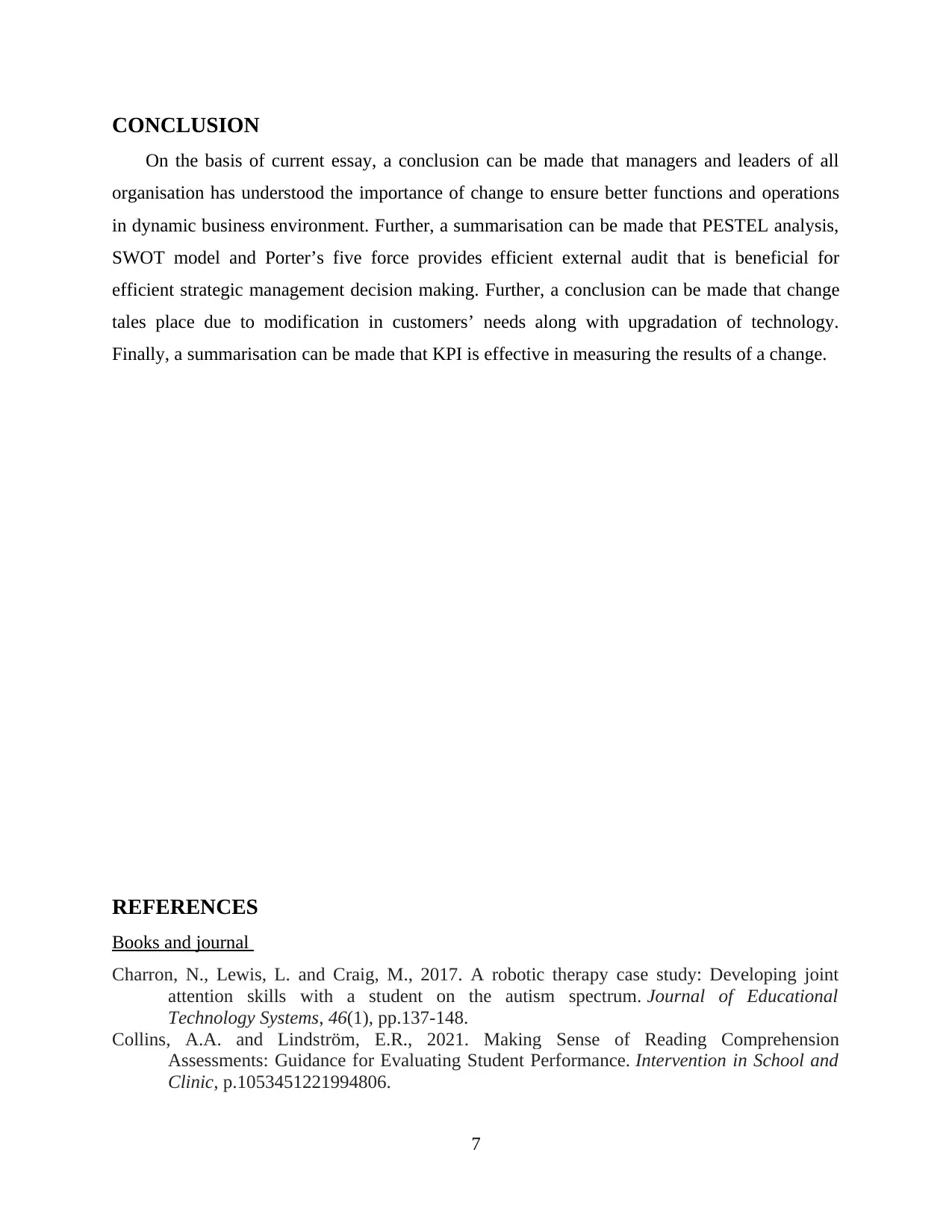
CONCLUSION
On the basis of current essay, a conclusion can be made that managers and leaders of all
organisation has understood the importance of change to ensure better functions and operations
in dynamic business environment. Further, a summarisation can be made that PESTEL analysis,
SWOT model and Porter’s five force provides efficient external audit that is beneficial for
efficient strategic management decision making. Further, a conclusion can be made that change
tales place due to modification in customers’ needs along with upgradation of technology.
Finally, a summarisation can be made that KPI is effective in measuring the results of a change.
REFERENCES
Books and journal
Charron, N., Lewis, L. and Craig, M., 2017. A robotic therapy case study: Developing joint
attention skills with a student on the autism spectrum. Journal of Educational
Technology Systems, 46(1), pp.137-148.
Collins, A.A. and Lindström, E.R., 2021. Making Sense of Reading Comprehension
Assessments: Guidance for Evaluating Student Performance. Intervention in School and
Clinic, p.1053451221994806.
7
On the basis of current essay, a conclusion can be made that managers and leaders of all
organisation has understood the importance of change to ensure better functions and operations
in dynamic business environment. Further, a summarisation can be made that PESTEL analysis,
SWOT model and Porter’s five force provides efficient external audit that is beneficial for
efficient strategic management decision making. Further, a conclusion can be made that change
tales place due to modification in customers’ needs along with upgradation of technology.
Finally, a summarisation can be made that KPI is effective in measuring the results of a change.
REFERENCES
Books and journal
Charron, N., Lewis, L. and Craig, M., 2017. A robotic therapy case study: Developing joint
attention skills with a student on the autism spectrum. Journal of Educational
Technology Systems, 46(1), pp.137-148.
Collins, A.A. and Lindström, E.R., 2021. Making Sense of Reading Comprehension
Assessments: Guidance for Evaluating Student Performance. Intervention in School and
Clinic, p.1053451221994806.
7
⊘ This is a preview!⊘
Do you want full access?
Subscribe today to unlock all pages.

Trusted by 1+ million students worldwide
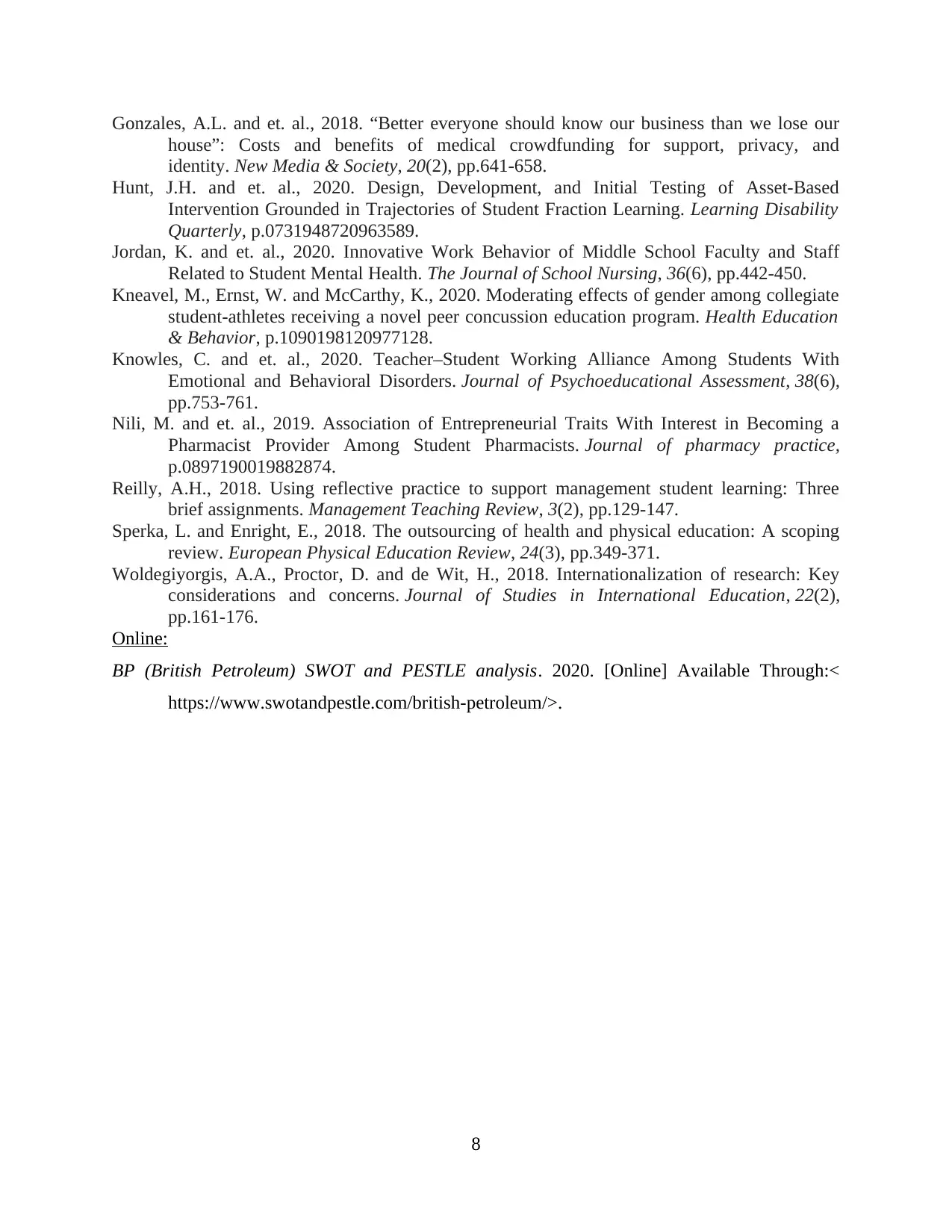
Gonzales, A.L. and et. al., 2018. “Better everyone should know our business than we lose our
house”: Costs and benefits of medical crowdfunding for support, privacy, and
identity. New Media & Society, 20(2), pp.641-658.
Hunt, J.H. and et. al., 2020. Design, Development, and Initial Testing of Asset-Based
Intervention Grounded in Trajectories of Student Fraction Learning. Learning Disability
Quarterly, p.0731948720963589.
Jordan, K. and et. al., 2020. Innovative Work Behavior of Middle School Faculty and Staff
Related to Student Mental Health. The Journal of School Nursing, 36(6), pp.442-450.
Kneavel, M., Ernst, W. and McCarthy, K., 2020. Moderating effects of gender among collegiate
student-athletes receiving a novel peer concussion education program. Health Education
& Behavior, p.1090198120977128.
Knowles, C. and et. al., 2020. Teacher–Student Working Alliance Among Students With
Emotional and Behavioral Disorders. Journal of Psychoeducational Assessment, 38(6),
pp.753-761.
Nili, M. and et. al., 2019. Association of Entrepreneurial Traits With Interest in Becoming a
Pharmacist Provider Among Student Pharmacists. Journal of pharmacy practice,
p.0897190019882874.
Reilly, A.H., 2018. Using reflective practice to support management student learning: Three
brief assignments. Management Teaching Review, 3(2), pp.129-147.
Sperka, L. and Enright, E., 2018. The outsourcing of health and physical education: A scoping
review. European Physical Education Review, 24(3), pp.349-371.
Woldegiyorgis, A.A., Proctor, D. and de Wit, H., 2018. Internationalization of research: Key
considerations and concerns. Journal of Studies in International Education, 22(2),
pp.161-176.
Online:
BP (British Petroleum) SWOT and PESTLE analysis. 2020. [Online] Available Through:<
https://www.swotandpestle.com/british-petroleum/>.
8
house”: Costs and benefits of medical crowdfunding for support, privacy, and
identity. New Media & Society, 20(2), pp.641-658.
Hunt, J.H. and et. al., 2020. Design, Development, and Initial Testing of Asset-Based
Intervention Grounded in Trajectories of Student Fraction Learning. Learning Disability
Quarterly, p.0731948720963589.
Jordan, K. and et. al., 2020. Innovative Work Behavior of Middle School Faculty and Staff
Related to Student Mental Health. The Journal of School Nursing, 36(6), pp.442-450.
Kneavel, M., Ernst, W. and McCarthy, K., 2020. Moderating effects of gender among collegiate
student-athletes receiving a novel peer concussion education program. Health Education
& Behavior, p.1090198120977128.
Knowles, C. and et. al., 2020. Teacher–Student Working Alliance Among Students With
Emotional and Behavioral Disorders. Journal of Psychoeducational Assessment, 38(6),
pp.753-761.
Nili, M. and et. al., 2019. Association of Entrepreneurial Traits With Interest in Becoming a
Pharmacist Provider Among Student Pharmacists. Journal of pharmacy practice,
p.0897190019882874.
Reilly, A.H., 2018. Using reflective practice to support management student learning: Three
brief assignments. Management Teaching Review, 3(2), pp.129-147.
Sperka, L. and Enright, E., 2018. The outsourcing of health and physical education: A scoping
review. European Physical Education Review, 24(3), pp.349-371.
Woldegiyorgis, A.A., Proctor, D. and de Wit, H., 2018. Internationalization of research: Key
considerations and concerns. Journal of Studies in International Education, 22(2),
pp.161-176.
Online:
BP (British Petroleum) SWOT and PESTLE analysis. 2020. [Online] Available Through:<
https://www.swotandpestle.com/british-petroleum/>.
8
1 out of 10
Related Documents
Your All-in-One AI-Powered Toolkit for Academic Success.
+13062052269
info@desklib.com
Available 24*7 on WhatsApp / Email
![[object Object]](/_next/static/media/star-bottom.7253800d.svg)
Unlock your academic potential
Copyright © 2020–2025 A2Z Services. All Rights Reserved. Developed and managed by ZUCOL.




